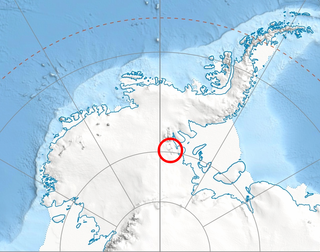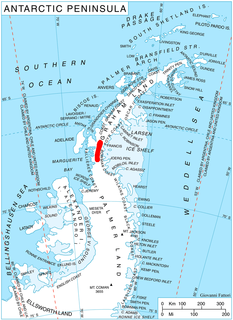Skytrain Ice Rise is a large, flattish, peninsula-like ice rise of about 50 miles extent, extending from the vicinity of Meyer Hills in the Heritage Range eastward into the Ronne Ice Shelf of Antarctica.
Ketchum Glacier is an eastward flowing glacier at the base of Palmer Land, Antarctica, about 50 nautical miles (90 km) long, descending between the Latady Mountains and the Scaife Mountains into Gardner Inlet. It was discovered by the Ronne Antarctic Research Expedition (RARE), 1947–48, under Finn Ronne, who named it for Commander Gerald Ketchum, U.S. Navy, commander of the icebreaker USS Burton Island (AG-88) which broke the ice to free the RARE from Marguerite Bay for the return home.
The Quartermain Mountains are a group of exposed mountains in Antarctica, about 32 kilometers long, typical of ice-free features of the McMurdo Dry Valleys, Victoria Land, located south of Taylor Glacier and bounded by Finger Mountain, Mount Handsley, Mount Feather and Tabular Mountain; also including Knobhead, Terra Cotta Mountain, New Mountain, Beacon Heights, Pyramid Mountain, Arena Valley, Kennar Valley, Turnabout Valley and the several valleys and ridges within Beacon Valley.
The Humboldt Mountains are a group of mountains immediately west of the Petermann Ranges, forming the westernmost portion of the Wohlthat Mountains in Queen Maud Land, Antarctica.

The McDonald Ice Rumples constitute an ice rise in the Brunt Ice Shelf bordering the Weddell Sea in Antarctica, covering an area of 3 by 2 nautical miles.

El-Sayed Glacier is a glacier about 15 nautical miles long which drains the northeast slopes of Zuncich Hill in Marie Byrd Land. It flows northeast to enter Land Glacier at the south side of Mount Shirley. It was mapped by the United States Geological Survey from surveys and U.S. Navy air photos, 1959–65, and was named by the Advisory Committee on Antarctic Names for Sayed Z. El-Sayed, a United States Antarctic Research Program oceanographer on the International Weddell Sea Oceanographic Expeditions, 1967–68 and 1969–70.

Ice Gate Glacier is a narrow hanging glacier, tributary to Astudillo Glacier, between rock spurs on the west slope of Dallmeyer Peak, Danco Coast, Antarctica. It was named by the Polish Antarctic Expedition in about 1992, probably from the gatelike appearance of the spurs at the junction of the two glaciers.
The Land Glacier is a broad, heavily crevassed glacier, about 35 nautical miles (60 km) long, descending into Land Bay in Marie Byrd Land, Antarctica. It was discovered by the U.S. Antarctic Service (1939–41) and named for Rear Admiral Emory S. Land, Chairman of the U.S. Maritime Commission.
Patuxent Ice Stream is a broad Antarctic ice stream between the Patuxent Range and Pecora Escarpment in the Pensacola Mountains, draining northwestward to the upper part of Foundation Ice Stream. Mapped by U.S. Geological Survey (USGS) from surveys and U.S. Navy (USN) air photos, 1956-66. Named by Advisory Committee on Antarctic Names (US-ACAN) for its proximity to the Patuxent Range.
Doake Ice Rumples is an area of disturbed ice in the Ronne Ice Shelf, extending for about 55 nautical miles (100 km) in a northwest–southeast direction between Korff Ice Rise and Henry Ice Rise. It was first visited and mapped in part by the US–International Geophysical Year geophysical traverse party from Ellsworth Station 1957–58, led by Edward Thiel, and was further delineated from U.S. Landsat imagery taken 1974 and from radio echo sounding by the British Antarctic Survey (BAS) in 1981. It was named by the UK Antarctic Place-Names Committee after Christopher S.M. Doake, a senior BAS glaciologist from 1973, who has contributed to an understanding of the morphology and dynamics of the Ronne Ice Shelf.
The Gutenko Mountains are a large, scattered group of hills, nunataks and small mountains at the south end of Dyer Plateau in central Palmer Land, Antarctica. The feature includes the Elliott Hills, the Rathbone Hills, the Guthridge Nunataks and the Blanchard Nunataks. These mountains were seen from the air during flights of November 21 and December 23, 1947, by the Ronne Antarctic Research Expedition and are named for Sigmund Gutenko, U.S. Navy, chief commissary steward with the expedition. The mountains were mapped in detail by the United States Geological Survey in 1974.
Duffy Peak is a peak southeast of Hageman Peak in the Staccato Peaks, southwest Alexander Island, Antarctica. Dargomyzhsky glacier extends and flows west from the base of Duffy Peak and enters the nearby Bach Ice Shelf. The peak was photographed from the air by Lincoln Ellsworth in 1935, and was named by the Advisory Committee on Antarctic Names for Lieutenant Commander Joseph A. Duffy, a U.S. Navy aircraft pilot in Squadron VXE-6 during Operation Deep Freeze, 1969 and 1970.
Hansen Inlet is an ice-filled inlet between Cape Schlossbach and Cape Cox, along the east coast and near the base of the Antarctic Peninsula. It was mapped by the United States Geological Survey from ground surveys and U.S. Navy air photos, 1961–67, and was named by the Advisory Committee on Antarctic Names for B. Lyle Hansen who, with Herbert T. Ueda, was in charge of the deep-core drilling program at Byrd Station for several seasons, 1966–69.
Matthews Glacier is a glacier on the east side of the Wilkins Mountains, Antarctica, draining south to enter the Ronne Ice Shelf just west of Dodson Peninsula. It was mapped by the United States Geological Survey from surveys and U.S. Navy air photos, 1961–67, and was named by the Advisory Committee on Antarctic Names for J.D. Matthews, an engineman at South Pole Station in 1963.

MacNamara Glacier is a glacier in the Patuxent Range of the Pensacola Mountains in Antarctica, draining northeastward between the Thomas Hills and Anderson Hills to Foundation Ice Stream. It was mapped by the United States Geological Survey from surveys and U.S. Navy air photos, 1956–66, and was named by the Advisory Committee on Antarctic Names for Edlen E. MacNamara, a United States Antarctic Research Program exchange scientist at Molodezhnaya Station, winter 1967.
Manna Glacier is a broad depression-glacier located north of Stevenson Bluff and Mount Steele in the Wilson Hills of Antarctica. It drains northeastward into the eastern part of the Gillett Ice Shelf. The glacier was so named by the northern party of the New Zealand Geological Survey Antarctic Expedition, 1963–64, because of an airdrop of extra comforts from an aircraft which carried the Governor-General of New Zealand over this area was like "manna from heaven".

Schanz Glacier is a glacier 8 nautical miles long in the Heritage Range, draining south between Soholt Peaks and Collier Hills to enter Union Glacier. It was mapped by United States Geological Survey (USGS) from surveys and U.S. Navy air photos in 1961 to 1966. It was named by Advisory Committee on Antarctic Names (US-ACAN) for Lieutenant Commander Thomas L. Schanz, supply officer with U.S. Navy Squadron VX-6 during Deep Freeze in 1965.
Land Bay is an ice-filled bay, about 40 nautical miles (70 km) wide, indenting the coast of Marie Byrd Land, Antarctica, just eastward of Groves Island. It was discovered by the United States Antarctic Service (1939–41), and takes its name from Land Glacier which descends into the bay.

Lewis Glacier is the northerly of two glaciers flowing from Hemimont Plateau east into Seligman Inlet, on the east coast of Graham Land, Antarctica. The glacier was photographed from the air by the United States Antarctic Service in 1940. It was charted in 1947 by the Falkland Islands Dependencies Survey, who named it for British glaciologist William Vaughan Lewis, a lecturer at the Department of Geography, Cambridge University.

Severinghaus Glacier is a glacier flowing southwestward from Karnare Col along the north side of Mount Strybing and the south side of Mount Craddock into Bender Glacier in southern Sentinel Range, Ellsworth Mountains in Antarctica. Named by the US-ACAN (2006) after Jeffrey P. Severinghaus, University of Rhode Island Graduate School of Oceanography; USAP researcher from 1996 on the history of the atmosphere, including greenhouse gases, and history of climate changes, using the ice core record.







